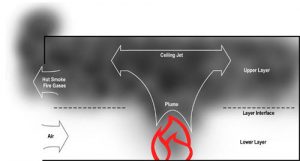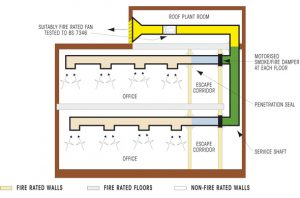
This area looks at smoke control by means of natural (displacement of exhaust) ventilation, powered (extract or exhaust and de-pressurization) ventilation or a combination of both.
Smoke control by means of pressurization is described separately
Design Standards
1. Smoke control system shall be designed, tested, selected, installed and maintained in accordance to:
2. S.1780 : 2005 Smoke Control System Using Natural (Displacement) or Powered (Extraction) Ventilation.
3. S.5588 Parts 4, 7, 10, 11 (B.S. to be omitted?)
4. S.7346 Parts 1, 2, 3 (B.S. to be omitted?)
5. S.4422 Part 5 (B.S. to be omitted?)
6. R. 186 and 258 (B.S. to be omitted?)
7. Other acceptable standards (should clarify this item)
8. Fire Safety Engineering – Performance-based Approach

Design Concepts
Smoke obscures visibility and can contribute towards fatalities in a fire incident. In fact smoke kills more people in fires than heat, flames or structural collapse. It is therefore increasingly realized that occupant safety in a fire can be greatly improved by providing efficient smoke control systems. Moreover, such systems can limit property damage, both directly by reducing the spread of smoke, and indirectly by providing better visibility and thus easier access to the seat of the fire for fire fighters.
Smoke control is one of the tools which the fire safety engineer may use to ensure adequate fire safety within integral part of the total package of fire safety measures designed for the building. Thus the need for smoke control in any building must be designed in conjunction with the means of escape, compartmentation and active suppression systems. Smoke control should be considered under the following circumstances.
Smoke Control for Life Safety
Smoke control for life safety purposes is of benefit in buildings where means of escape to the open air cannot be achieved within a short period of time and in which the means of escape could be severely contaminated with smoke and become impassable. Examples include shopping malls, atrium buildings and high rise buildings with phased evacuation i.e. when a proportion of the occupants are expected to stay in the building for the duration or part duration of the fire.
Smoke Control for Fire Fighter Access
Smoke extraction for fire fighter access is desirable for buildings where either:
- fire brigade access is difficult, e.g. basements and high rise buildings; or
- rapid attack on fire is necessary to reduce fire spread and property damage.



